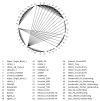In Search of Novel Degradation-Resistant Monomers for Adhesive Dentistry: A Systematic Review and Meta-Analysis
- PMID: 36551861
- PMCID: PMC9775292
- DOI: 10.3390/biomedicines10123104
In Search of Novel Degradation-Resistant Monomers for Adhesive Dentistry: A Systematic Review and Meta-Analysis
Abstract
This study aimed to assess whether degradation-resistant monomers included in experimental dental adhesives can improve long-term bond strength compared to conventional monomers. This study followed the latest PRISMA guidance (2020). The search for the systematic review was carried out in four electronic databases: PubMed/Medline, Scopus, SciELO and EMBASE, without restrictions on the year of publication and language. The last screening was conducted in July 2022. Interventions included were in vitro studies on experimental dental adhesives that tested short-term and long-term bond strength, but also water sorption and solubility data when available, in extracted human molars. Meta-analyses were performed using Rstudio v1.4.1106. A summary table analyzing the individual risk of bias was generated using the recent RoBDEMAT tool. Of the 177 potentially eligible studies, a total of 7 studies were included. Experimental monomers with acrylamides or methacrylamide−acrylamide hybrids in their composition showed better results of aged bond strength when compared to methacrylate controls (p < 0.05). The experimental monomers found better sorption and solubility compared to controls and were significantly different (p < 0.001). It is possible to achieve hydrolytically resistant formulations by adding novel experimental monomers, with chemical structures that bring benefit to degradation mechanisms.
Keywords: acrylate monomers; degradation-resistant; dental adhesion; dentin bonding agents; hybrid layer; hydrolysis: hydrolytically resistant; resin-based materials.
Conflict of interest statement
The authors declare no conflict of interest.
Figures







References
Publication types
LinkOut - more resources
Full Text Sources

